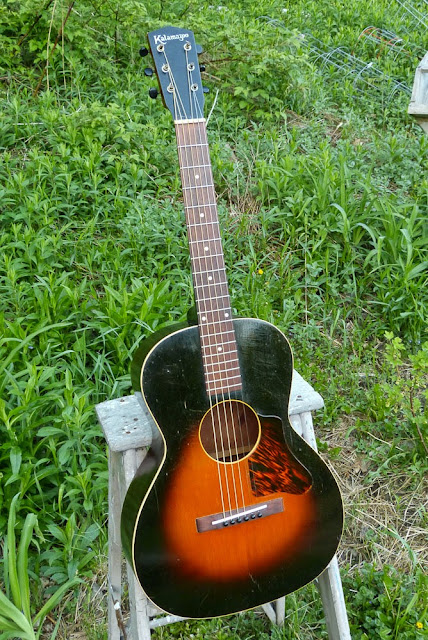1937 Gibson-made Kalamzoo KHG-14 Flattop Guitar
This is a really cool guitar. Per the Fox Guitars website, this specs-out as a KHG-14 -- which I could've told you -- and the serial places it at 1937. It began life as a Hawaiian version (straight saddle and raised strings for Hawaiian/lap slide play) but I've converted it to regular "Spanish" play. Compared to a normal 14-fret KG-14, this 12-fret model puts the bridge in a bit more of a "sweet spot" and thus this trades some up-front volume and snap for a bit more of a round, fuller tone.
Work included pulling the fretboard extension, reshaping, and regluing it, a bridge shave and re-slotting to install a new compensated bone saddle, bridge plate cap (more on that later), fret level/dress (believe it or not, but a few frets actually had wear in addition to small neck relief), cleaning, and setup. Everything aside from the mod to the bridge and the new saddle are original to the guitar... even all the pins! It plays spot-on with a straight neck (3/32" bass, 1/16" treble action at the 12th fret) and is currently strung with 50w-11 strings.
The 12-fret "L-00" body shape looks really nice blended with that 30s-cool two-tone sunburst and the firestripe pickguard. There are no real cracks on the guitar (amazing!), though there's a surface-level (not-through) tiny hairline/finish crack that you can see on the top at the bass "waist" area.
The nut width is giant -- 1 15/16" -- which puts it just shy of 2" across. The nut is original and bone. The finish chipped when I removed it to do the fret work and that's why you see a little line below the EAD strings. Some bone dust got in the little finish flaked area after I recut the nut slots.
The (Brazilian) rosewood fretboard is radiused, has pearl dots and side dots, and standard old-style smallish Gibson fret stock. It's all nearly full-height, thought and feels good. The neck profile is that standard Gibson medium-full V shape for the time, but the wide nut makes it feel bigger. If you have small hands or are scared of big necks, stay away!
For me, it feels at home for fingerpicking or cowboy chords, though the 12-fret sound makes it a nice counterpoint/fills flatpicker.
While the finish is still largely glossy, it does show tons of weathercheck and use-wear as well as a little bit of pickwear. The top edge and soundhole are bound in cream celluloid.
I had to shave the bridge as well as convert it over to a compensated slot for the saddle. I also "capped" the bridge plate/strapping brace to give more room for the wrappings on the end of the strings so they wouldn't ride over the saddle. That wasn't a consideration when this was made as it was intended as a Hawaiian and had a much taller saddle.
I used "strapping brace" (cedar top stock, in this case) material to make the cap -- which is roughly similar to what the bridge plate/strapping brace already installed is (spruce). It in no way effects the tone as it's such a lightweight addition and is much more practical than letting the wrappings run over the top of the saddle.
The black pins are the originals and look great.
The back, sides, and neck are all solid mahogany and have zero cracks.
A bit of lube was all it took to get the tuners operating happily.
Here you can see the medium-full V neck profile.
The endpin is original, too.
This guitar has an old chip case that comes with it, but I didn't bother to take pictures of it as it isn't very exciting and serves pretty much for storage/shipping use.



















Comments
-Jake
I suggest you leave them alone, period. One really oughtn't just go 'round chopping off extensions willy-nilly.
Perhaps a spell at luthiery school would do you some good.
Cheerio~
Just because I -don't- go all the way with a repair job doesn't mean I don't have the ability. I disagree that every piece of equipment should be treated like it can afford $500-1000 worth of repairs (most of which are simply not necessary). The above guitar plays well, sounds great, and if I didn't mention that I'd adjusted the extension, no one would probably ever know it had been done. I don't see any reason to hide work that doesn't hurt, but rather improves, an instrument.
So, rant over.